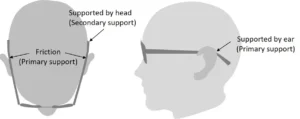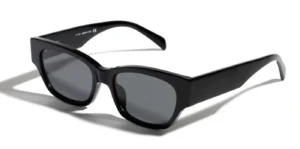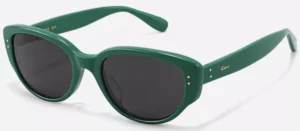For eyeglasses wearers, comfort and durability are top priorities when choosing a new pair of frames. While many eyeglass factors contribute to these qualities, the weight and balance of the eyeglass frames play a significant role. An optimally weighted glass frame sits comfortably on the face without putting pressure on the nose or ears. It also maintains proper alignment without slipping down the face throughout the day.
Getting the weight distribution just right can improve the user experience tremendously. However, achieving this balance is far from straightforward for sunglasses manufacturers. It requires deep consideration of material selection, structural design, and adjustable features during product development. With years of research, sunglasses designers have gained valuable insights that contribute to producing lightweight yet robust frames.
This article explores the nuances of weight distribution in eyeglass frame design. We’ll discuss the key factors that influence weight balance and how manufacturers strategically address them. Read on to learn about material selection, structural optimization, personalized fittings, and wear testing that goes into creating frames with impeccable comfort through natural weight equilibrium.
It is very important for designing sunglasses and how to create your own sunglasses brand.

1. Materials Matter for Lightweight Strength
Selecting high-quality, lightweight materials is paramount for achieving the ideal weight balance in glass frames. Frame designers have a wide palette of material options to choose from, each with their own properties to consider.
Plastic is one of the most common frame materials due to its versatility and affordability. Nylon, acetal, polycarbonate, and Trivex are popular thermoplastics that can be easily molded into intricate shapes. Their relatively low densities provide natural lightweight capacity compared to metals. However, due to their amorphous molecular structures, plastics may not withstand heavy impact as well.
To bolster durability, many premium frames incorporate metal alloys like titanium. Though density is higher, titanium is incredibly strong yet lightweight. Other options include stainless steel and nickel-titanium alloy (Nitinol), which maintains elasticity through its shape memory effect. These metals require additional manufacturing steps like CNC machining but result in exceptionally hardy frames.
Cutting-edge materials are continuously entering the market as well. Zyl is a proprietary blend touted as stronger than polycarbonate yet 30% lighter. Grilamid TR-90 balances strength and flexibility through a nylon composite. Such specialized engineered thermoplastics give designers more flexibility in structural designs without sacrificing robustness or balance.
Careful consideration of frame material properties informs optimal placements throughout the design. For example, a lightweight plastic may constitute most of the outer opticals for minimal weight, reinforced by discrete metal strengthening elements. Multiplying material options strategically using thin gauges is key.
2. Structural Optimization for Ergonomic Weight Distribution
Beyond sheer material selection, the frame’s structural architecture heavily impacts equilibrium and user experience. Modeling and testing prototypes helps engineers refine specifications ensuring lightweight flow and stability.
Areas receiving the most stress like the temple hinges call for concentrated reinforcing. At the same time, tapering cross-sectional thicknesses where possible prevents weight build-up. Intricate ribbing, webbing, and geometric cut-outs likewise shave grams efficiently.
Nose pads connect the two optical fronts, taking significant vertical weight. Reducing pad size and optimizing mounts maintain sturdiness while keeping weight centered along the bridge. Meanwhile, adjustable pads cater to anatomical variety between users.
Invisible weighted balancing beads strategically placed at hinge screws or inside slider mechanisms counteract canting forces. Integrated stabilizing elements within plastic components like liquid silicone rubber (LSR) further bolster frames through the whole range of motion.
Developers normalize weight distribution through iterative modeling cycles paired with physical testing. Simulating motions like resting on the cheekbones or sitting down identifies any tendency to slip or tilt. Repeated stress tests assess structural fatigue from daily wear and tear. Only frames meeting performance thresholds advance to human trials.
3. User Fitting Cultivates Custom Comfort
Even with meticulous engineering, one size seldom fits all given anatomical variations. Manufacturers incorporate adjustable elements tuned through personalized fittings maximizing wearer-specific balance and support.
Key features might include multifunction nose pads for optimal grip and tilt angles, as well as oversized bolsters allowing forward-backward nuance. For certain metal alloys like nitinol, shape memory qualities shape comfortably upon wearing. Flexible hinges yield precisely as needed yet retain cut without slippage.
Precision measurements map each customer’s facial geometry, mapping pressure points, and preferred placement. Based on feedback during dynamic activities, professional opticians fine-tune hardware tightness or pad positioning.
Marking frames also locate balance focal points along temple and nose contours. For example, an unbalanced wearer may need reinforcing along the outer cheeks or inner temple tips. Customized balancing optimizes weight effectivity through minimal, focused solutions.
4. Wear Testing Reveals Real-World Performance
While satisfying in-house simulations and static fittings, the true test lies in real-world performance over time. Frames undergo rigorous controlled wear trials simulating months or years of daily use within a compressed timeframe.
Automated machines cycle through repetitive motions mimicking jaw movement, resting positions, taking off, and putting on glasses. Dialed stress variations engage frames from all angles through thousands of activity simulations.
Other test rigs mount frames on dynamic mechanical heads performing countless head tilts, turns, and bobs. Repeated over months, they identify any early plastic creep, metal fatigue cracks, or weld/hinge failures that escape standard tests.
Final verification employs human testers in natural environments. With tracking monitors, their daily motions and activity levels authentically stress glasses. Engineers assess long-term durability and note subtle divergences from the initial fitted balance. Mishaps provide insights into overlooked weaknesses.
Only through extensive wear simulations do imbalances over prolonged use fully surface. Issues requiring re-engineering may include disproportionate weight migration upon 100% plastic creep relaxation or metal spring weakening. Frames must maintain balanced poise throughout many years’ worth of motions.
5. Constant Refinement for Enduring Quality
As with any product, optimizing eyewear comfort and longevity demands ongoing refinement. Input from verification reports rolls improvements back into structural redesigns, material updates, and quality control measures.
Technological innovations likewise inspire the reevaluation of established methods. Additive manufacturing, for example, enables new lightweight cellular infill structures while metal 3D printing produces intricate alloy frames. Artificial intelligence may one day automate customized fittings.
Quality assurance protocols scrutinize each manufacturing run, filtering any nonconforming units. Regular audits revalidate suppliers, machines, and assembly technicians upholding specifications rigorously. Corrective actions address even minuscule variances from calibrated norms.

Conscientious manufacturers continuously challenge status quo designs. They welcome outside evaluations from professional and consumer lenses to spot flaws perhaps overlooked internally. Customer feedback circuits into prototypes addressing unforeseen issues.
Weight balance as critical as it is proves an ongoing pursuit of optimization rather than a quick fix. Only through this relentless improvement culture do frames withstand everyday stresses comfortably for years on end. The diligent efforts reward wearing experiences customers love.
6. In Conclusion
Getting the weight distribution right involves deep collaboration between optical engineers, industrial designers, material scientists, and opticians. Their collective expertise cultivates a holistic understanding of how frames interface with the human body dynamically.
Through meticulous material selection, structural engineering Analysis, customized fittings, and rigorous wear simulations, manufacturers aim to achieve natural equilibrium complementing diverse anatomical profiles. Ongoing quality measures safeguard consistency throughout large-scale production as well.
When executed skillfully, these techniques yield eyeglasses maintaining well-balanced lightness comfortably on any face. Wearers whose needs evolve also appreciate customizable elements allowing fine adjustments. Ultimately, the comfort and dependability afforded by optimally distributed weight enhance everyday vision correction and protection. Frame designers’ diligence translates meaningfully to enjoyable wearing experiences and customer satisfaction.



